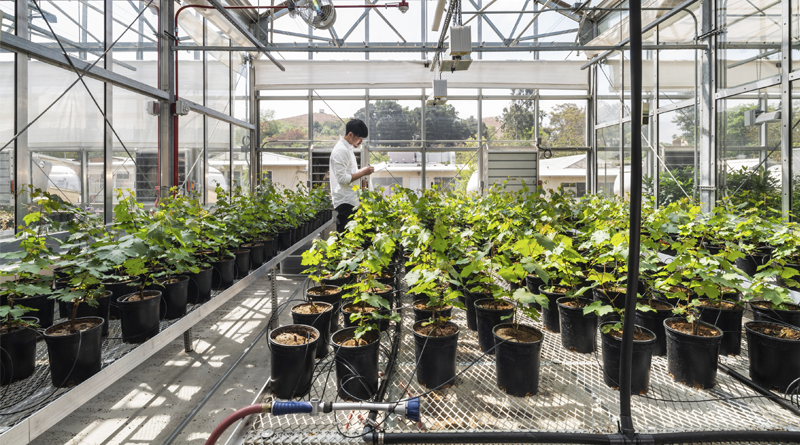UC Riverside Debuts New Plant-Based Research Facility
By Eric Althoff
RIVERSIDE, Calif.—Things are certainly growing at the University of California, Riverside. Designer Perkins&Will and general contractor DPR Construction, along with personnel from UCR, recently gathered in celebration of a new state-of-the-art greenhouse and agricultural research building for UCR’s College of Natural and Agricultural Sciences (CNAS).
This two-story, 30,000-square-foot greenhouse project will allow CNAS faculty and students to conduct growth studies and learn more about feeding an expanding population. Some of the early work undertaken there entails investigating how bees pollinate flowers in different environments as well as testing how rice can be made to be more resistant to floods and drought conditions that are only becoming more dire as the planet warms. Other research will be undertaken to examine how climate-control tech can be applied to serve various other agricultural needs.
The architectural design features a serrated concrete wall on the lower level that can help regulate shifts in internal temperature more naturally rather than relying on HVAC exclusively. The main level offers specific rooms for potting, growth chambers as well as breakrooms. The facility’s second level features 16 individual greenhouse modules that can be customized for specific studies and research.
“I’m thrilled about the amazing work being facilitated in the new CNAS Plant Research building,” said Jessica Orlando, associate principal and higher education practice leader at Perkins&Will Los Angeles. “Our team feels so privileged to have contributed to the delivery of a functional, high-performance building that also creates a stunning design that pays homage to UC Riverside’s rich campus fabric.”
Perkins&Will personnel took as inspiration for their design motif the nearby greenhouses, whose gables were reproduced in a new way for the upper glass roof of the Plant Research building. Meanwhile, the structure employs minimal use of concrete, glass and steel in a nod to more eco-conscious development. Furthermore, each upper-level greenhouse is wrapped in double-pane polarized glass, allowing observers to watch experimenters at work.
Climate control for each individual greenhouse module can be manipulated to simulate a variety of different weather settings and levels of humidity. A large evaporative cooling system works for the entire building, and researchers also can modulate the amount of natural light entering into each individual module.
“It was important for us to couple practical functionality and the aesthetic roots of the surrounding greenhouses with the college’s forward-looking spirit and focus on scientific innovation,” said August Miller, senior designer at Perkins&Will. “This ultimately translated to a series of greenhouse modules, each its own independent laboratory, at the upper level.”
Added Yan Krymsky, design director of Perkins&Will’s Los Angeles studio: “It’s really a machine, a tool for research. But beyond that, we wanted to create a structure that spoke to the legacy of the university.”
The CNAS sits on a part of the UCR campus formerly occupied by older greenhouses. In fact, the school originally started out as University of California Citrus Experiment Station in 1907, eventually changing to UCR.
Perkins&Will was founded in 1935 and employs over 2,000 people in 20 studios around the world. The firm’s Los Angeles studio is located in the heart of the historic downtown.

